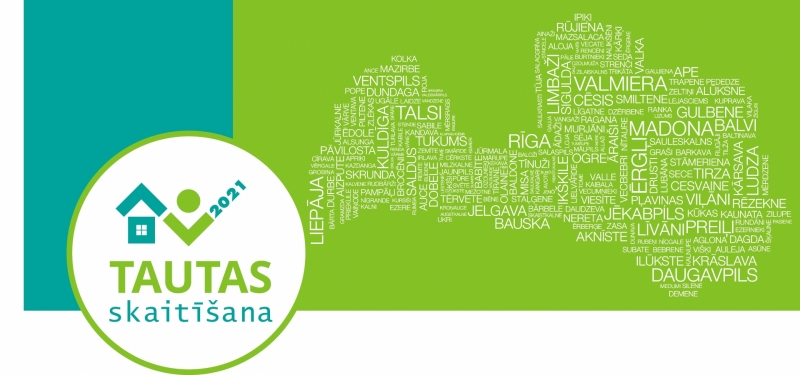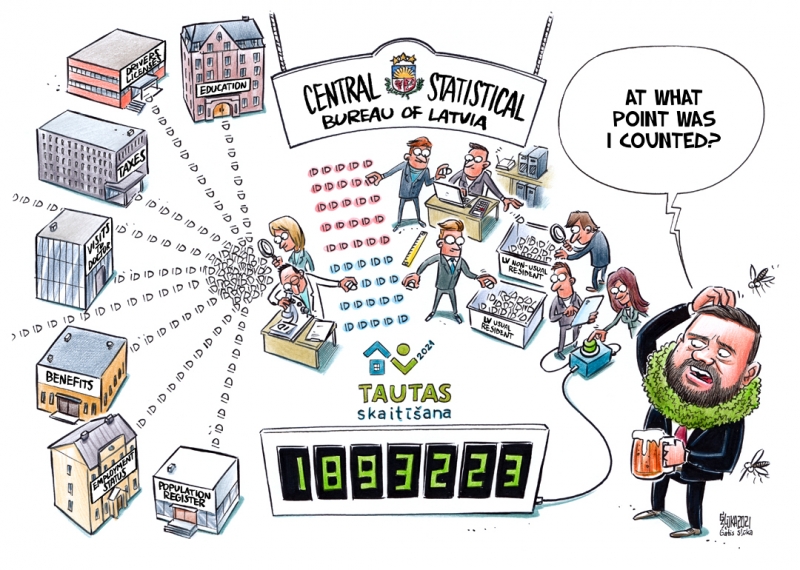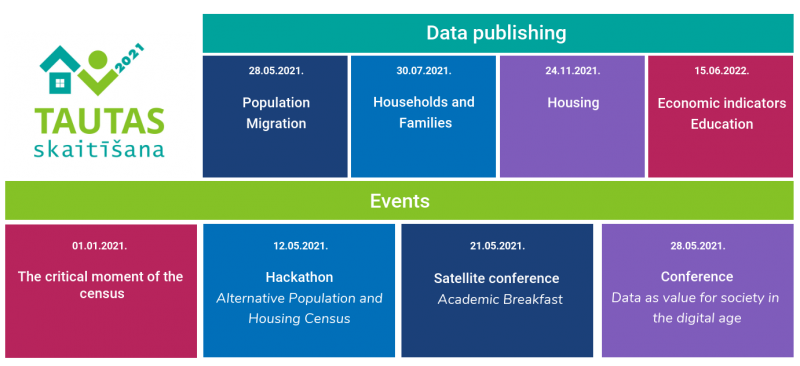The census is one of the most important sources of information, which is the basis for the official statistics of the state. The main purpose of the census is to obtain up-to-date information on the entire population, which is widely used in the public and private sectors, such as:
- data on the number and composition of the usually resident population help to make decisions in the fields of demography, education, health, social protection and employment;
- provides data for population and housing forecasts, which are necessary for service planning and decision-making;
- allows for research work, resulting in conclusions which would characterize the population.
In Latvia, the data of the Census 2021 correspond to the situation on 1 January.
The process of the census
Until now, information for Population and Housing Census was compiled by census enumerators who visited each household, systematically recording information about the persons living there and their dwellings. Such censuses involved a large number of employees, which increased costs and was a time-consuming process.
In 2021, the census in Latvia is done with a new method, based on administrative data and without carrying out the classical survey of residents at their dwellings. In 2011, this data collection method was used in the Scandinavian countries, Finland, the Netherlands, Austria and Slovenia, and in 2021 the Baltic States, Spain and Turkey join this group of countries. The use of administrative data allows data to be obtained, processed and published in much shorter time period.
Administrative data used
Latvia has many high-quality, regularly updated registers and databases with a wide coverage, such as the Office of Citizenship and Migration Affairs, the State Revenue Service, the State Social Insurance Agency and other state information systems, as well as other registers and databases where information on both residents as well as their dwellings is available; a single personal identifier (personal identification number) is used to access these registers and databases, which allows for better data compatibility in order to provide more complete data coverage. This information is used in the preparation of Population and Housing Census data.
In order to prepare for the census based on administrative data, work on the identification of possible data sources, data collection, evaluation of the quality of data, preparation of indicators and development of methodology was started already in 2012. This has enabled the authorities in charge of the registers to improve their quality as well as eliminate errors and inaccuracies. This cooperation between institutions contributes to improving the quality of registers and databases, making the use of these data more efficient for the public.
In order to ensure secure data retention and compatibility, preparation of indicators for both the census and social statistics surveys, the CSB has established a Social Statistics Data Warehouse.
Currently, the census database includes data from 34 different registers and databases, containing municipal information on demolished and uninhabitable residential buildings, as well as information from municipal companies on the provision of district heating, district water/sewerage (data from more than 70 companies).
Indicators
In accordance with the Cabinet Regulation of 10 December 2019 No. 588 “Regulations Regarding the Population and Housing Census 2021” indicators have been determined, which are also published in the CSB database. In total, six main groups of indicators can be distinguished: demography, migration, households and families, education, economic indicators and housing.
A detailed description of the Census 2021 indicators and the regulation related to the census (on the provision of comprehensive population and housing censuses every ten years) are included in the Regulation (EC) No 763/2008 of the European Parliament and of the Council of 9 July 2008 on population and housing censuses as well as in the list of indicators to be published set out in Commission Implementing Regulation (EU) 2017/543.
Extended indicator methodology and information on data quality are available in accordance with the SIMS2 standard (in English) and in the Census section (in Latvian).
Results of the census in Latvia
Database tables:
- Population and key indicators (including migration indicators)
- Family and household indicators
- Housing indicators
- Indicators characterizing educational attainment and activity of the population
Results of Census 2000 and Census 2011
A conference, dedicated to the Population and Housing Census 2021 and organized by the CSB
On 28 May 2021, the Central Statistical Bureau organized a conference dedicated to the Population and Housing Census 2021, and the guiding principle of the conference was a change of the paradigm and method when carrying out the Population and Housing Census 2021 in the digital age.
Since the previous census, a new data collection system which uses administrative data sources has been set up. The most important precondition that determines the development of census data acquisition is the growing demand for timely, up-to-date and detailed data. The required data will now be available every year instead of every 10 years.
Now we can assess that the chosen path has been a correct one. Analyzing the obtained census results and findings, it is necessary to assess how to move forward using individual data.
Conference participants had the opportunity to evaluate following three aspects:
- Registers and the future;
- Data opening and detailing;
- Legal aspects, confidentiality, and protection of personal data.
Two consecutive sessions happened in the conference: the first target audience were national data users (state and local government institutions as well as media), while the second session was focused on foreign national statistical institutions and the academia.
Two satellite events took place during the conference:
- Hatchback of census data “Alternative Population and Housing Census” 12.05.2021 – 14.05.2021 (awarding the winners during the conference);
- Satellite conference “Academic Breakfast” 21.05.2021.
Regulations
Statistics Law
Cabinet Regulation No. 588 of 10 December 2019 “Regulations Regarding the Population and Housing Census 2021”.
Cabinet Order No 777 of 19 December 2017 “Amendments to the Action Plan for the Designing and Organisation of the Population and Housing Census 2021”.
Cabinet Order No 766 of 19 December 2017 “On the Date of the Current Census”.
Cabinet Order No 281 of 2 June 2015 “On Long-Term Commitments of the State Budget to the New Policy Initiative “Designing and Organization of the Population and Housing Census 2021” and for data processing until 2023".
Cabinet Order No 280 of 2 June 2015 No. 280 “On the Action Plan for Designing and Organisation of the Population and Housing Census 2021”.
Commission Implementing Regulation (EU) 2018/1799 of 21 November 2018 on the establishment of a temporary direct statistical action for the dissemination of selected topics of the 2021 population and housing census geocoded to a 1 km2 grid.
Commission Implementing Regulation (EU) 2017/881 of 23 May 2017 implementing Regulation (EC) No 763/2008 of the European Parliament and of the Council on population and housing censuses, as regards the modalities and structure of the quality reports and the technical format for data transmission, and amending Regulation (EU) No 1151/2010.
Commission Regulation (EU) 2017/712 of 20 April 2017 establishing the reference year and the programme of the statistical data and metadata for population and housing censuses provided for by Regulation (EC) No 763/2008 of the European Parliament and of the Council.
Commission Implementing Regulation (EU) 2017/543 of 22 March 2017 laying down rules for the application of Regulation (EC) No 763/2008 of the European Parliament and of the Council on population and housing censuses as regards the technical specifications of the topics and of their breakdowns.
Regulation (EC) No 763/2008 of the European Parliament and of the Council of 9 July 2008 on population and housing censuses.





